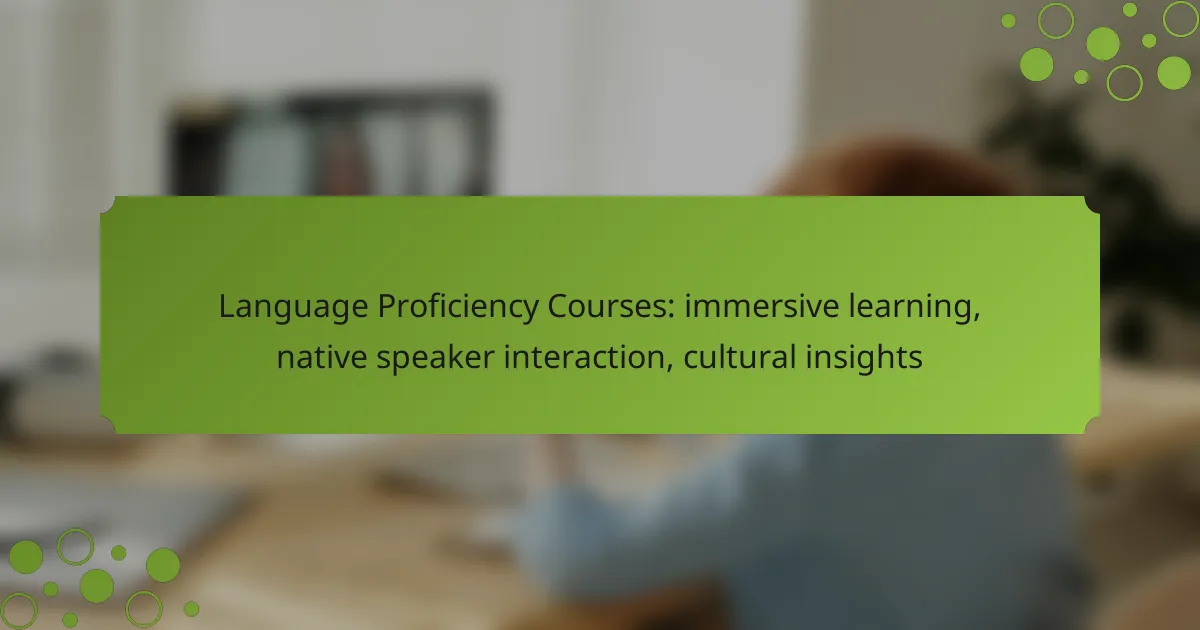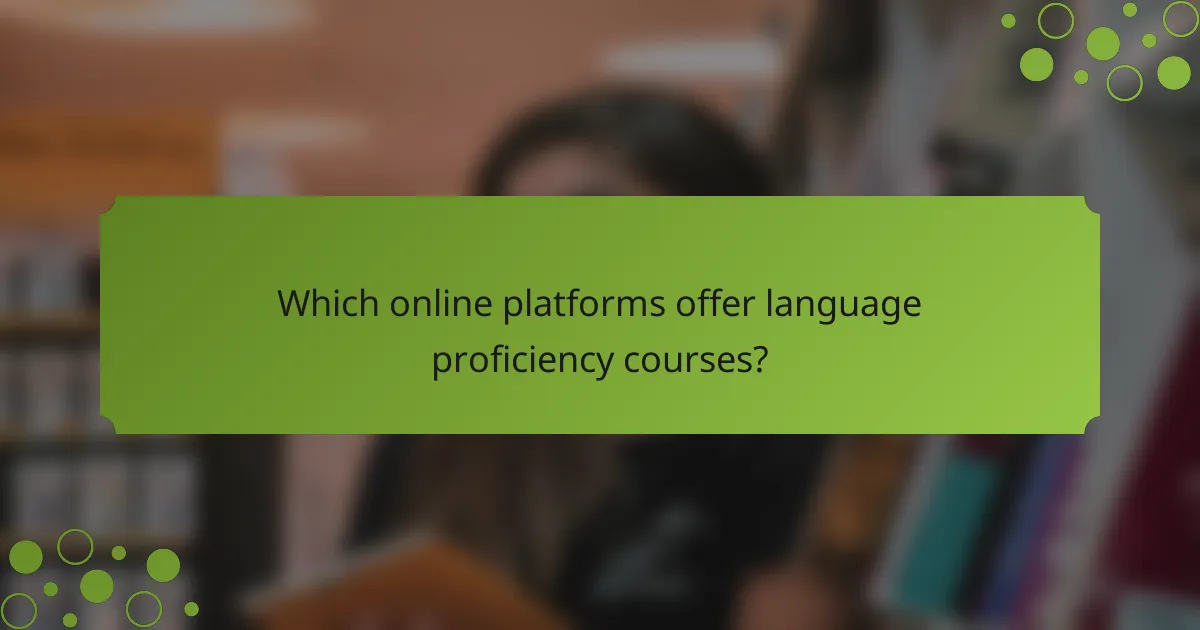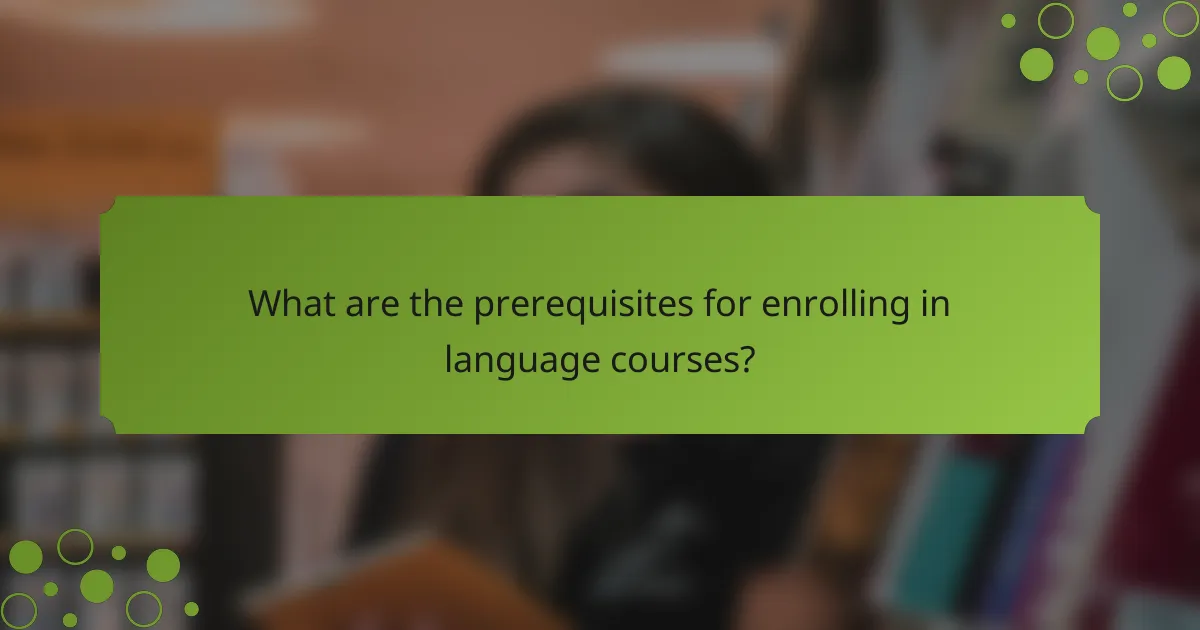
Language proficiency courses designed for immersive learning offer a unique opportunity to engage with real-world contexts, enhancing language skills through direct interaction with native speakers. These courses not only improve conversational abilities but also provide valuable cultural insights, enriching the overall learning experience. With various online platforms available, learners can easily find a course that aligns with their individual preferences and learning styles.

How do immersive language proficiency courses work?
Immersive language proficiency courses focus on engaging learners in real-world contexts to enhance their language skills. These courses typically involve interaction with native speakers, cultural experiences, and practical applications of the language in everyday situations.
Interactive learning environments
Interactive learning environments are designed to foster active participation and engagement among learners. This can include group discussions, role-playing activities, and peer-to-peer conversations that simulate real-life interactions.
For instance, learners might participate in a cooking class conducted in the target language, allowing them to practice vocabulary related to food and cooking while collaborating with others. Such environments help build confidence and fluency through practical use.
Real-life scenarios and simulations
Real-life scenarios and simulations provide learners with the opportunity to practice language skills in contexts they are likely to encounter. This could involve navigating a market, ordering food at a restaurant, or participating in a community event.
By engaging in these simulations, learners can develop their conversational skills and cultural understanding. For example, a simulation of a job interview can prepare learners for actual interviews in the target language, enhancing both their language proficiency and cultural awareness.
Use of multimedia resources
Multimedia resources play a crucial role in immersive language courses, as they cater to various learning styles and enhance engagement. These resources can include videos, podcasts, and interactive apps that provide exposure to authentic language use.
Utilizing multimedia allows learners to hear native pronunciation, understand colloquial expressions, and see cultural contexts. For example, watching a film in the target language with subtitles can improve listening skills and comprehension while providing cultural insights.

What are the benefits of native speaker interaction?
Native speaker interaction significantly enhances language proficiency by providing real-time feedback and authentic communication experiences. Engaging with native speakers allows learners to practice conversational skills, improve comprehension, and gain insights into cultural nuances.
Improved pronunciation and fluency
Interacting with native speakers helps learners develop better pronunciation and fluency in their target language. Hearing the correct pronunciation in context allows students to mimic sounds and intonation patterns, leading to more natural speech. Regular conversations can also help learners become more comfortable with the rhythm and flow of the language.
To maximize these benefits, learners should seek opportunities for consistent practice, such as language exchange meetups or online conversation partners. Engaging in discussions on various topics can further enhance fluency and confidence.
Authentic cultural exchanges
Native speaker interaction provides valuable cultural insights that are often missing from traditional language courses. Through conversations, learners can explore customs, traditions, and social norms, which enrich their understanding of the language. This cultural context can make learning more relevant and engaging.
Participating in cultural events or community activities with native speakers can deepen these exchanges. For instance, attending local festivals or cooking classes can offer practical experiences that complement language learning and foster connections with the culture.

Which online platforms offer language proficiency courses?
Several online platforms provide language proficiency courses that focus on immersive learning, native speaker interaction, and cultural insights. These platforms cater to different learning styles and preferences, making it easier to find one that suits your needs.
Rosetta Stone
Rosetta Stone is renowned for its immersive approach, emphasizing visual and auditory learning without translation. The platform uses a dynamic immersion method, allowing learners to engage with the language through real-life scenarios and interactive exercises.
Key features include speech recognition technology to improve pronunciation and a wide range of languages available. Subscriptions typically range from monthly to annual plans, with costs varying based on the chosen duration and language.
Duolingo
Duolingo offers a gamified learning experience that makes language acquisition fun and engaging. Users can practice vocabulary and grammar through bite-sized lessons that feel like games, encouraging consistent daily practice.
The platform is free with optional premium features available through a subscription. Duolingo supports numerous languages and is particularly popular among beginners looking to build foundational skills.
Babbel
Babbel focuses on conversation skills and practical language use, making it ideal for learners who want to communicate effectively in real-world situations. The courses are designed by linguistic experts and cover a variety of topics relevant to everyday life.
Babbel operates on a subscription model, with options for monthly or yearly payments. Users can expect structured lessons that adapt to their progress, ensuring a tailored learning experience.

What cultural insights can be gained from language courses?
Language courses provide valuable cultural insights by immersing learners in the nuances of local customs, dialects, and traditions. Engaging with native speakers and participating in cultural activities enhances understanding and appreciation of the language’s context.
Understanding local customs
Learning about local customs is essential for effective communication and relationship-building. Language courses often include discussions on etiquette, social norms, and traditions that shape interactions in a specific culture. For example, in Japan, understanding the importance of bowing and gift-giving can significantly impact social engagements.
To gain a deeper understanding, consider participating in cultural events or festivals related to the language you are studying. This firsthand experience can provide context to the phrases and expressions learned in class, making them more meaningful.
Exploring regional dialects
Regional dialects can vary significantly, even within the same language, affecting pronunciation, vocabulary, and expressions. Language courses that focus on these differences help learners navigate local conversations more effectively. For instance, in Spain, the distinction between Castilian and Andalusian Spanish showcases unique linguistic features that can influence comprehension.
When studying a language, pay attention to the dialect spoken in the area you wish to engage with. Listening to local media, such as radio stations or podcasts, can enhance your familiarity with regional variations and improve your overall fluency.

How to choose the right language proficiency course?
Selecting the right language proficiency course involves evaluating the course’s content, structure, and the qualifications of its instructors. Focus on your learning goals, preferred teaching methods, and the cultural insights offered to ensure a comprehensive learning experience.
Assessing course content and structure
Examine the curriculum to ensure it aligns with your language goals, whether for conversational fluency, academic proficiency, or professional use. Look for courses that offer immersive learning experiences, such as interactive activities and real-life scenarios, which enhance retention and practical application.
Consider the course duration and frequency of classes. A well-structured course typically spans several weeks to months, with regular sessions that facilitate consistent practice. Check if the course includes opportunities for native speaker interaction, as this can significantly boost your speaking and listening skills.
Evaluating instructor qualifications
Research the instructors’ backgrounds to ensure they possess relevant qualifications and experience in teaching the language. Native speakers with teaching certifications often provide valuable insights into cultural nuances and language use.
Look for reviews or testimonials from former students to gauge the effectiveness of the instructors. A good instructor should not only be knowledgeable but also skilled in engaging students and adapting lessons to different learning styles.

What are the prerequisites for enrolling in language courses?
Prerequisites for enrolling in language courses typically include a basic understanding of the language, a willingness to engage in immersive learning, and sometimes a placement test to assess your current proficiency level. These factors help ensure that students can fully benefit from the course structure and content.
Basic language knowledge
Having basic language knowledge is essential before enrolling in language courses. This usually means familiarity with fundamental vocabulary and grammar rules, which allows learners to participate actively in discussions and exercises. For instance, knowing common phrases and sentence structures can significantly enhance your learning experience.
Many language programs expect students to have a foundational grasp of the language, which can often be assessed through a placement test. This test helps instructors tailor the course to meet the needs of all participants, ensuring that everyone is on a similar level and can progress together.
If you are starting from scratch, consider taking introductory courses or using language learning apps to build your basic knowledge before enrolling. This preparation can make a substantial difference in your confidence and ability to engage with native speakers during the course.


